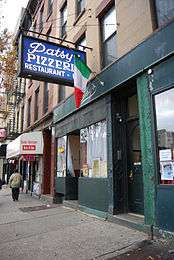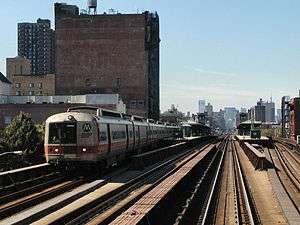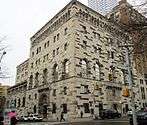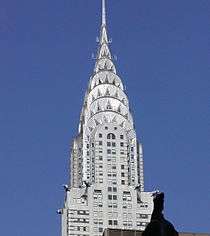East Harlem
Coordinates: 40°47′52.64″N 73°56′24.17″W / 40.7979556°N 73.9400472°W
| East Harlem | |
|---|---|
| Neighborhood of Manhattan | |
|
Second Avenue at 97th Street | |
| Country |
|
| State |
|
| City | New York City |
| Borough | Manhattan |
| Population (2010) | |
| • Total | 116,000 (est.) |
| Ethnicity | |
| • Hispanic | 52.1% |
| • Black | 35.7% |
| • White (non-Hispanic) | 7.3% |
| • Asian | 2.7% |
| • Other | 0.2% |
| Economics | |
| • Median income | $21,480 |
| ZIP code | 10029, 10035 |
| Area code(s) | 212, 917, 646 |
East Harlem, also colloquially known as El Barrio and previously as Spanish Harlem, is a neighborhood of Upper Manhattan, New York City roughly encompassing the area north of the Upper East Side and East 96th Street up to about the 140s,[1] east of Fifth Avenue to the East and Harlem Rivers.[2] It lies within Manhattan Community District 11.[3] Despite its name, it is generally not considered to be a part of Harlem.[4]
The neighborhood is one of the largest predominantly Latino communities in New York City, mostly made up of Puerto Ricans, as well as sizeable numbers of Dominican and Cuban immigrants. It includes the area formerly known as Italian Harlem, in which the remnants of a once predominantly Italian community remain. The Chinese population has increased dramatically in East Harlem since 2000.[5][6][7][8]
East Harlem has historically suffered from many social issues, such as the highest jobless rate in New York City, teenage pregnancy, AIDS, drug abuse, homelessness, and an asthma rate five times the national average.[3] It has the second highest concentration of public housing in the United States, closely following Brownsville, Brooklyn.[9] Police services to the neighborhood are divided between the 23rd and the 25th Precincts.[10] Conversely, East Harlem is notable for its contributions to Latin freestyle and salsa music.
However, East Harlem is now undergoing some gentrification.[11] In February 2016, East Harlem was one of four neighborhoods featured in an article in The New York Times about "New York’s Next Hot Neighborhoods".[1]
History
Early history
The area which became East Harlem was rural for most of the 19th century, but residential settlements northeast of Third Avenue and East 110th Street had developed by the 1860s.[12] The construction of the elevated transit line to Harlem in 1879 and 1880, and the building of the Lexington Avenue subway in 1919,[12] urbanized the area, precipitating the construction of apartment buildings and brownstones. The extension of cable cars up Lexington Avenue into East Harlem was stymied by the incline created by Duffy's Hill at 103rd Street, one of the steepest grades in Manhattan. East Harlem was first populated by poor German, Irish, Scandinavian,[13] and Eastern European Jewish immigrants, with the Jewish population standing at 90,000 around 1917.[12] In the 1870s, Italian immigrants joined the mix after a contractor building trolley tracks on First Avenue imported Italian laborers as strikebreakers. The workers' shantytown along the East River at 106th Street was the beginning of an Italian neighborhood, with 4,000 having arrived by the mid 1880s. As more immigrants arrived, it expanded north to East 115th Street and west to Third Avenue.[14]
East Harlem now consisted of pockets of ethnically-sorted settlements – Italian, German, Irish, and Jewish – which were beginning to press up against each other, with the spaces still between them occupied by "gasworks, stockyards and tar and garbage dumps".[14] In 1895, Union Settlement Association, one of the oldest settlement houses in New York City, began providing services in the area, offering the immigrant and low-income residents a range of community-based programs, including boys and girls clubs, a sewing school and adult education classes.
Italian Harlem
Southern Italians and Sicilians, with a moderate number of Northern Italians, soon predominated, especially in the area east of Lexington Avenue between 96th and 116th Streets and east of Madison Avenue between 116th and 125th Streets, with each street featuring people from different regions of Italy. The neighborhood became known as "Italian Harlem", the Italian American hub of Manhattan; it was the first part of Manhattan to be referred to as "Little Italy".[15] The first Italians arrived in East Harlem in 1878, from Polla in the province of Salerno, and settled in the vicinity of 115th Street.[16]
There were many crime syndicates in Italian Harlem from the early Black Hand to the bigger and more organized Italian gangs that formed the Italian-American Mafia. It was the founding location of the Genovese crime family, one of the Five Families that dominated organized crime in New York City.[17] This includes the current 116th Street Crew of the Genovese family. During the 1970s, Italian East Harlem was also home to the Italian-American drug gang and murder-for-hire crew known as the East Harlem Purple Gang.
In the 1920s and early 1930s, Italian Harlem was represented in Congress by future Mayor Fiorello La Guardia, and later, in the 1950s and 1960s, by Italian-American civil rights lawyer, activist, and socialist Vito Marcantonio. The Italian neighborhood approached its peak in the 1930s, with over 100,000 Italian-Americans living in its crowded, run-down apartment buildings.[18] The 1930 census showed that 81 percent of the population of Italian Harlem consisted of first- or second-generation Italian Americans. (Somewhat less than the concentration of Italian Americans in the Lower East Side’s Little Italy with 88 percent; Italian Harlem’s total population, however, was three times that of Little Italy.)[16]
The Italian community in East Harlem remained strong into the 1980s, but it has slowly diminished since then. However, Italian inhabitants and vestiges of the old Italian neighborhood remain. The annual Feast of Our Lady of Mount Carmel and the "Dancing of the Giglio", the first Italian feast in New York City, is still celebrated there every year on the second weekend of August by the Giglio Society of East Harlem. Italian retail establishments still exist, such as Rao's restaurant, started in 1896, and the original Patsy's Pizzeria which opened in the 1933. In May 2011, one of the last remaining Italian retail businesses in the neighborhood, a barbershop owned by Claudio Caponigro on 116th Street, was threatened with closure by a rent increase.[19]
Spanish Harlem
Puerto Rican and Latin American immigration after the First World War[20] established an enclave at the western portion of East Harlem – around 110th Street and Lexington Avenue – which became known as "Spanish Harlem". The area slowly grew to encompass all of East Harlem, including Italian Harlem, as Italians moved out – to the Bronx, Brooklyn, upstate New York and New Jersey – and Hispanics moved in during another wave of immigration in the 1940s and 1950s.[12] Although in certain areas, particularly around Pleasant Avenue, Italian Harlem lasted through the 1970s,[21] today most of the former Italian population is gone. Most of these predominantly older residents are clustered around Our Lady of Mount Carmel Church, mainly from 114th to 118th Streets. According to the 2000 Census, there were only 1,130 Italian-Americans still living in this area.[22]
The newly dominant Puerto Rican population, which reached 63,000 in 1950, continued to define the neighborhood according to its needs, establishing bodegas and botánicas as it expanded; by the 1930s[20] there was already an enclosed street market underneath the Park Avenue railroad viaduct between 111th and 116th Streets, called "La Marqueta" ("The Market").[12] Catholic and evangelistic Protestant churches appeared in storefronts.[12] Although "Spanish Harlem" had been in use since at least the 1930s to describe the Hispanic enclave – along with "Italian Harlem" and "Negro Harlem"[23] – the name began to be used to describe the entire East Harlem neighborhood by the 1950s. Later, the name "El Barrio" ("The Neighborhood") began to be used, especially by inhabitants of the area.
Decline
In the 1950s and 1960s, large sections of East Harlem were leveled for urban renewal projects, and the neighborhood was one of the hardest hit areas in the 1960s and 1970s as New York City struggled with deficits, race riots, urban flight, gang warfare, drug abuse, crime and poverty. Tenements were crowded, poorly maintained, and frequent targets for arson. In 1969 and 1970, a regional chapter of the Young Lords which were reorganized from a neighborhood street gang in Chicago by Jose (Cha-Cha) Jimenez, ran several programs including a Free Breakfast for Children and a Free Health Clinic to help Latino and poor families. The Young Lords came together with the Black Panthers and called for Puerto Rican independence and neighborhood empowerment. Still, as of the early 2000s, the Latin Kings gang was still prevalent in East Harlem.
Recent history
By the beginning of the 21st century, East Harlem was a racially diverse neighborhood, with about a third of the population being Puerto Rican.[12] As it has been throughout its history, it is predominantly a working-class neighborhood.[13]
Until 2006, property values in East Harlem climbed along with those in the rest of New York City. With increased market-rate housing, including luxury condos and co-ops - most built on formerly vacant lots - there has been some decline of affordable housing in the community. A number of young professionals have settled into these recently constructed buildings. This influx of "yuppies" has caused rents to rise, more buildings in the area to get gut renovations and is changing area demographics.[24]
On March 12, 2014 at 9:00 EDT, a large explosion and fire at 1644–1646 Park Avenue killed eight people and injured more than 70.[25][26]
The New York Post listed one part of the neighborhood – the block of Lexington Avenue between East 123rd and 124th Streets – as one of "the most dangerous blocks in the city" because police crime statistics for 2015 showed that 19 assaults had taken place there, more than for any other city block. The Post also reported that there were, according to the Harlem Neighborhood Block Association, "22 drug-treatment programs, four homeless-services providers and four transitional-living facilities" in East Harlem.[27]
In February 2016, an article in The New York Times about "New York’s Next Hot Neighborhoods" featured East Harlem as one of four such areas. A real-estate broker described it as "one of the few remaining areas in New York City where you can secure a good deal". The article mentioned new luxury developments, access to transportation, the opening of new retail stores, bars and restaurants, and national-brand stores beginning to appear on the outskirts of the neighborhood. Primarily, though, it was the cost of housing in comparison to the rest of Manhattan, which the article noted as the major factor.[1]
Demographics

Manhattan Community District 11, which covers East Harlem in its entirety, is a mostly low and moderate income area. It is made up of first and second generation Puerto Ricans, African-Americans, Asians, West Indians (Especially Dominicans and Cubans), and a growing population of Mexicans, Salvadorans, and other Central American immigrants.
It has one of the highest concentrations of Puerto Ricans in all of New York City. In the 2000 Census, 52.1% of residents described themselves as of Hispanic origin, 35.7 as non-Hispanic black, 7.3 as non-Hispanic white, 2.7 Asian and Pacific Islander Nonhispanic, 1.7% as two or more non-Hispanic races, and 0.5% as another race. By New York City averages, the youth makes up a larger than normal percentage of the East Harlem population with 30.6% of residents age 18 or younger.[3]
93.6% of all housing units were renter-occupied, and over 25% of the population resided in public housing units managed by the NYCHA. 46.5 percent of the population receive a form of income support by the government.[3]
According to a 2010 study, the number of Asians in East Harlem nearly tripled between 2000 and 2010, largely due to Chinese people moving to East Harlem. Increasing rents in Lower Manhattan's Chinatown have driven many into public and subsidized housing developments in the neighborhood. Advocates have been calling for Chinese language services to be available in the community centers to accommodate the growing number of Chinese residents in the area. In 2000, the Chinese population in the northern portion was less than one percent, but by 2010, it has gone up to being three percent in the area. In the southern part, it rose from 4.6% to 8.4%.[28][29][30]
As of 2010, the Puerto Rican population was 27.7% in zip code 10029,[31] and 23.4% in 10035. 10035 also has a large Mexican population, at 10.7%.[32]
Transportation

The Harlem River separates the Bronx and Manhattan, necessitating several spans between the two New York City boroughs. In East Harlem, the Wards Island Bridge, also known as the 103rd Street Footbridge, connects Manhattan with Wards Island. The Triboro Bridge is a complex of three separate bridges that offers connections between Queens, Manhattan (Harlem), and the Bronx.[33]
Public transportation service is provided by the Metropolitan Transportation Authority. This includes the New York City Subway—the IRT Lexington Avenue Line (4 5 6 <6> trains) at 125th Street—and MTA Regional Bus Operations, as well as the Metro-North Harlem – 125th Street commuter rail station, connecting to Westchester County and Connecticut. Some local bus Bronx routes also serve Manhattan, to provide customers with access to both boroughs.[34]
Social issues
Social problems, including poverty, crime, and drug addiction, have plagued the area since the 1970s. Although crime rates have dropped from the historically high numbers of the past, East Harlem suffers from Manhattan's highest violent crime rate, with 15 murders in 2011.[35]
East Harlem has the highest concentration of shelters and facilities in Manhattan, with eight homeless shelters, 36 drug and alcohol treatment facilities and 37 mental health treatment facilities. It also has the highest jobless rate in the entire city, as well as the city's second highest cumulative AIDS rate. The asthma rate is also 5 times larger than national levels.[3] The neighborhood also suffers from a high poverty rate.[36] Union Settlement Association is one of the neighborhood's largest social service agencies, reaching more than 13,000 people annually at 17 locations throughout East Harlem, through a range of programs, including early childhood education, youth development, senior services, job training, the arts, adult education, nutrition, counseling, a farmers' market, community development, and neighborhood cultural events.

Fresh food
A lack of access to healthy food causes serious hardships to citizens of East Harlem, a neighborhood which is considered to be a food desert. According to an April 2008 report prepared by the New York City Department of City Planning, East Harlem is an area of the city with the highest levels of diet-related diseases due to limited opportunities for citizens to purchase fresh foods.[37]
With a high population density and a lack of nearby supermarkets, the neighborhood has little access to fresh fruit and vegetables and a low consumption of fresh foods. Citizens of East Harlem are likely to buy food from grocery stores that have a limited supply of fruits and vegetables, which are often of poor quality and generally more expensive than the same products sold at supermarkets. Compared to the Upper East Side, supermarkets in Harlem are 30% less common.[38] Without access to affordable produce and meats, East Harlem residents have difficulty eating a healthy diet, which contributes to high rates of obesity and diabetes.[39]
In 2011, Manhattan Borough President Scott Stringer announced a program which would send Veggie Vans to East Harlem senior centers and housing projects.[40] In 2012, Whole Foods announced two uptown locations, one being on 125th Street and Lenox Avenue, the other in the Upper East Side.[41] In 2010, Aldi's Grocery opened at the East River Plaza [42] located at E. 117th St. and FDR Drive, providing access to affordable food for East Harlem's residents. In 2013, a new Super FI Emperior Grocery store opened up in East Harlem on 103rd Street and Lexington Avenue.[43]





Housing
East Harlem is dominated by public housing complexes of various types, with a high concentration of older tenement buildings between these developments. The neighborhood contains the highest geographical concentration of low income public housing projects in the United States. The total land area is 1.54 square miles (4.0 km2).[44][45]
After a wave of arson ravaged the low income communities of New York City throughout the 1970s, many of the residential structures in East Harlem were left seriously damaged or destroyed. By the late 1970s, the city began to rehabilitate many abandoned tenement style buildings and designate them as low income housing.
Despite recent gentrification of the neighborhood, large numbers of apartment buildings have been deliberately kept vacant by their owners. Although the businesses on the ground floor are retained, landlords do not want to have the trouble involved in residential tenants. In some cases, landlords are waiting for a revived economy, warehousing the apartments so that they can rent them later at a higher rent.[46]
In 2007, a survey of Manhattan’s buildings found that 1,723 were significantly vacant, three-quarters of them north of 96th Street. A 1998 survey found that one-quarter of low-rise residential buildings on avenues or major cross streets in East Harlem had sealed-up residential floors, despite having commercial businesses on the ground floor.[46]
Public housing projects
There are twenty-four New York City Housing Authority developments located in East Harlem.[47]
- 335 East 111th Street; one, 6-story building.
- East 120th Street Rehab; one, 6-story rehabilitated tenement building.
- East River Houses; ten buildings, 6, 10 and 11-stories tall.
- Edward Corsi Houses; one, 16-story building.
- Gaylord White Houses; one, 20-story building.
- George Washington Carver Houses; 13 buildings, 6 and 15-stories tall.
- Governor Dewitt Clinton Houses; six buildings, 9 and 18-stories tall.
- Jackie Robinson Houses; one, 8-story building.
- James Weldon Johnson Houses; ten, 14-story buildings.
- Lehman Village; four, 20-story buildings.
- Lexington Houses; four, 14-story buildings.
- Metro North Plaza; three buildings, 7, 8, and 11-stories tall.
- Metro North Rehab; seventeen, 6-story rehabilitated tenement buildings.
- Milbank-Frawley; two rehabilitated tenement buildings 5 and 6-stories tall.
- Morris Park Senior Citizens Home; one, 9-story rehabilitated building.
- Park Avenue-East 122nd, 123rd Streets; two, 6-story buildings.
- President Abraham Lincoln; fourteen buildings, 6 and 14-stories tall.
- President George Washington Houses; fourteen buildings, 12 and 14-stories tall.
- President Thomas Jefferson Houses; eighteen buildings, 7, 13 and 14-stories tall.
- President Woodrow Wilson Houses; three, 20-story buildings.
- Senator Robert A. Taft; nine, 19-story buildings.
- Robert F. Wagner Houses; twenty-two buildings, 7 and 16-stories tall.
- U.P.A.C.A. (Upper Park Avenue Community Association) Site 6; one, 12-story building.
- U.P.A.C.A. (Upper Park Avenue Community Association) U.R.A. Site 5; one, 11-story building.
Other subsidized housing include:
- Taino Towers – East 122nd Street and Third Avenue. Four 35-story towers, 656 apartments. Opened 1979.[48]
Education and medical services
The schools in East Harlem are generally characterized by low test scores and high drop-out and truancy rates.[49] As in other parts of the city, some schools require students pass through metal detectors and swipe ID cards to enter school buildings.[50] Nevertheless, since 1982 the community has been home to the Manhattan Center for Science and Mathematics,[51] which replaced Benjamin Franklin High School, a school which had the smallest graduating class in the city at the time of its closing.[52]
Among the public charter schools in East Harlem are Success Academy Harlem 2 of Success Academy Charter Schools, the Harlem Village Academy, East Harlem Scholars Academies, and the DREAM Charter School.
Major medical care providers in the East Harlem area include Metropolitan Hospital Center and Mount Sinai Hospital, which serve residents of East Harlem and the Upper East Side. North General Hospital, which formerly served the area as well, is now closed. Many of the graduates of the Icahn School of Medicine at Mount Sinai do local public health work, including work on asthma, diabetes, unsafe drinking water, lead paint and infectious diseases.
Economy
The neighborhood is home to one of the few major television studios north of midtown, Metropolis at 106th Street and Park Avenue, where shows such as BET's 106 & Park and Chappelle's Show have been produced. PRdream.com, a web site on the history and culture of Puerto Ricans, founded a media gallery and digital film studio called MediaNoche in 2003. It presents technology-based art on Park Avenue and 102nd Street, providing exhibition space and residencies for artists and filmmakers, and webcasting events.
Notable people
|
|
Dave East (Rapper)
In popular culture
Music
- Ben E. King's song, "Spanish Harlem" (1961) and the 1966 cover of it by The Mamas & the Papas
- Bob Dylan's song "Spanish Harlem Incident" from his album Another Side of Bob Dylan (1964)
- Phil Ochs' song "Lou Marsh" from his album All the News That's Fit to Sing (1964)
- Louie Ramirez's song "Lucy's Spanish Harlem" from his album In the Heart of Spanish Harlem (1967)
- Elton John's "Mona Lisas and Mad Hatters" from Honky Château (1972)
- Paul Simon's song "Adios Hermanos" from his album Songs from The Capeman (1997)
- Van Morrison's song "Contemplation Rose" from his anthology album "Philosopher's Stone" (1998)[55]
- Carlos Santana's songs "Maria Maria" and "Smooth" from his album Supernatural (1999)
- Beirut's song, "East Harlem" (2011)
- Cocoa Brovaz, Tony Touch & Hurricane G's song, "Spanish Harlem" (1997)
Literature
- Piri Thomas's memoir Down These Mean Streets (1967)
- Ernesto Quiñonez's novels, Bodega Dreams (2000) and Chango's Fire (2005)
- Salvatore Mondello's novel A Sicilian in East Harlem (2005)
- Nora Roberts's novel Salvation in Death (2008)
Film
- The film Popi (1969), written by Tina Pine and Lester Pine and directed by Arthur Hiller
- Nelson Denis's film Vote For Me! (2003)
Music videos
- Frankie Cutlass's "Puerto Rico" music video was shot in Spanish Harlem (1994)
- Jay-Z's "Death of Autotune" music video was shot inside Rao's Italian restaurant (2009)
- ASAP Rocky's "Peso" music video features footage of East Harlem (2011)
Gallery
-
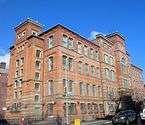
Julia de Burgos Latino Cultural Center, formerly P.S. 72
(1680 Lexington Ave.) -
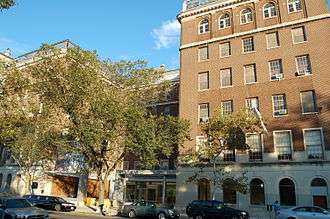
El Museo del Barrio
(1230 Fifth Ave.) -

Tunnels through the Metro-North viaduct
(Park Avenue and 105th St.) -

Hope Community Hall, formerly the 28th Precinct Station house
(177 East 103rd St.) -
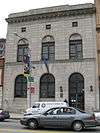
New York Public Library 125th St. Branch
(224 East 125th St.) -
All Saints Roman Catholic Church
(47 East 129th St.) -

Church of the Living Hope
(161 East 104th St.) -
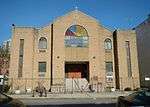
Greater Emmanuel Baptist Church
(325 East 118th St.) -

Hellenic Orthodox Church of Sts. George and Demetrios
(140 East 103rd St.)
References
Notes
- 1 2 3 Higgins, Michelle (February 26, 2016) "New York’s Next Hot Neighborhoods" The New York Times
- ↑ "El Barrio (Spanish Harlem) New York City.com : Visitor Guide : Editorial Review". Nyc.com. Retrieved September 19, 2012.
- 1 2 3 4 5 "Community District Needs" (PDF). Retrieved September 19, 2012.
- ↑ Gurock, Geoffrey S. et al. "Harlem" in Jackson, Kenneth T., ed. (2010), The Encyclopedia of New York City (2nd ed.), New Haven: Yale University Press, ISBN 978-0-300-11465-2, p.573
- ↑ Mays, Jeff. "East Harlem Tries to Serve Huge Influx of Chinese Residents – DNAinfo.com New York". Dnainfo.com. Retrieved June 9, 2013.
- ↑ Barron, Laignee (August 8, 2011). "Chinese population climbs 200% in Harlem and East Harlem over 10 yrs". NY Daily News. Retrieved June 9, 2013.
- ↑ "Chinese American Population in Harlem NYC Surges". apaforprogress.org. Retrieved June 9, 2013.
- ↑ Marc Santora (March 12, 2014). "At Least 3 Killed in Gas Blast on East Harlem Block; 2 Buildings Leveled". The New York Times. Retrieved March 12, 2014.
- ↑ Mays, Jeff (April 14, 2011). "Low-Income Parents Worry Cuts to Childcare Will Force Them Out of Work – DNAinfo.com New York". Dnainfo.com. Retrieved September 19, 2012.
- ↑ Feeney, Michael J. (May 11, 2012). "Plea for peace in East Harlem". New York Daily News. Retrieved September 19, 2012.
- ↑ Daniel Goodman (September 9, 2013). "New York's East Harlem: Neighborhood Fighting To Keep Its Culture In The Face Of Gentrification". Business Insider. Retrieved April 12, 2016.
- 1 2 3 4 5 6 7 8 9 10 Lapp, Michael. "East Harlem" in Jackson, Kenneth T., ed. (2010), The Encyclopedia of New York City (2nd ed.), New Haven: Yale University Press, ISBN 978-0-300-11465-2, pp.390–391
- 1 2 White, Norval; Willensky, Elliot; Leadon, Fran (2010), AIA Guide to New York City (5th ed.), New York: Oxford University Press, ISBN 9780195383867, p.548
- 1 2 Burrows, Edwin G. & Wallace, Mike (1999), Gotham: A History of New York City to 1898, New York: Oxford University Press, ISBN 0-195-11634-8, p.1123-24
- ↑ Nevius, Michelle & Nevius, James (2009), Inside the Apple: A Streetwise History of New York City, New York: Free Press, ISBN 141658997X p.154
- 1 2 Meyer,Gerald. "Italian Harlem: America’s Largest and Most Italian Little Italy"
- ↑ "Genovese Crime Family-One of the "Five Families"". American Mafia History. May 6, 2012. Retrieved September 19, 2012.
- ↑ Jackson, Kenneth T., ed. (1995), The Encyclopedia of New York City, New Haven: Yale University Press, ISBN 0300055366, p.605 "Their number increased slightly during the 1930s, when as many as 110,000 Italians lived east of Lexington Avenue between 96th and 116th streets and east of Madison Avenue between 116th and 125th streets."
- ↑ Berger, Joseph (May 13, 2011). "East Harlem Rent Tripling, Barber May Have to Close Shop After 60 Years". The New York Times. Retrieved May 13, 2011.
- 1 2 Federal Writers' Project (1939), New York City Guide, New York: Random House, ISBN 0-403-02921-X (Reprinted by Scholarly Press, 1976; often referred to as WPA Guide to New York City). p. 265-268
- ↑ Berger, Joseph (November 11, 2002). "Sit in This Chair, Go Back in Time; Barber Is Unchanged as Old Neighborhood Vanishes". The New York Times. p. 1. Retrieved May 28, 2011.
- ↑ Garland, Sarah. "A Reunion of Little Italy in East Harlem", The New York Times, September 5, 2006. Accessed January 2, 2008. "Now, there are only 1,130 Italian-Americans left in East Harlem, according to the 2000 census."
- ↑ Federal Writers' Project (1939), New York City Guide, New York: Random House, ISBN 0-403-02921-X (Reprinted by Scholarly Press, 1976; often referred to as WPA Guide to New York City), p.253
- ↑ "Yuppies Are Moving Into Notorious East Harlem". Business Insider. Nov 20, 2013. Retrieved November 20, 2013.
- ↑ "New York Gas Explosion Kills Six People" Sky News (March 13, 2014)
- ↑ Alcindor, Yamiche and Stanglin, Doug. "8th body found in ruins of East Harlem buildings" USA Today (March 13, 2014)
- ↑ Balsamini, Dean (March 6, 2016) "Do you live on one of New York's most dangerous blocks?" New York Post
- ↑ Mays, Jeff. "East Harlem Tries to Serve Huge Influx of Chinese Residents – DNAinfo.com New York". Dnainfo.com. Retrieved September 19, 2012.
- ↑ Barron, Laignee (August 8, 2011). "Chinese population climbs 200% in Harlem and East Harlem over 10 yrs". NY Daily News. Retrieved September 19, 2012.
- ↑ "Chinese American Population in Harlem NYC Surges". apaforprogress.org. Retrieved September 19, 2012.
- ↑ "2010 Census , /zip-code/10029/10029". Retrieved April 3, 2016.
- ↑ "2010 Census , /zip-code/10035/10035". Retrieved April 3, 2016.
- ↑ "Robert F. Kennedy Bridge". Mta.info. December 30, 2010. Retrieved February 2, 2013.
- ↑ "MTA New York City Transit". mta.info. Retrieved February 2, 2013.
- ↑
- "Police Department City of New York - CompStat - 25th Pct" (PDF). Retrieved September 19, 2012.
- "Police Department City of New York - CompStat - 23rd Pct" (PDF). Retrieved September 19, 2012.
- ↑ http://home2.nyc.gov/html/ceo/images/misc/chart_5.jpg
- ↑ "Socioeconomic & Housing – Going to Market: New York City'sNeighborhood Grocery Store andSupermarket Shortage". Nyc.gov. Retrieved September 19, 2012.
- ↑ "NYC.gov". NYC.gov. December 18, 2007. Retrieved September 19, 2012.
- ↑ "American Journal of Preventive Medicine – Supermarkets, Other Food Stores, and Obesity: The Atherosclerosis Risk in Communities Study". American Journal of Preventive Medicine. 30: 333–339. March 10, 2006. doi:10.1016/j.amepre.2005.11.003.
- ↑ "Veggie Vans Slated to Sell Fresh Produce in East Harlem – DNAinfo.com New York". Dnainfo.com. Retrieved September 19, 2012.
- ↑ "Whole Foods Plans New Stores for Harlem, Upper East Side". Wall Street Journal. Retrieved Oct 16, 2012.
- ↑ "East River Plaza". East River Plaza. Retrieved April 9, 2015.
- ↑ "Super FI Opens In Harlem". The Source. Retrieved July 26, 2013.
- ↑ "Manhattan Community Board 11" (PDF). nyc.gov. New York City Department of Planning. December 2007. Retrieved January 3, 2009.
- ↑ "Census Tract 240". US Census Bureau American Factfinder. US Census Bureau. Retrieved January 3, 2009.
- 1 2 "East Harlem Landlords Keep Apartments Sealed Up". The New York Times. October 31, 2011. Retrieved October 31, 2011.
- ↑ "NYCHA". Nyc.gov. Retrieved September 19, 2012.
- ↑ Baldwin, Susan, "Taino: 'Dream' Housing For Poor Set To Open: From 30 years ago: Long in the making, a unique subsidized housing project finally opened its doors", City Limits Magazine, January 5, 2009. This includes the original article: Baldwin, Susan, "Taino: 'Dream' Housing For Poor Set To Open", City Limits Magazine, February 1979, Vol. 4, No. 2
- ↑ "Area information about East Harlem in NYC". StreetEasy. Retrieved September 19, 2012.
- ↑ "East Harlem, Harlem, NY |". Harlemworldmag.com. October 10, 2010. Retrieved September 19, 2012.
- ↑ "MCSM.net". Mcsmportal.net. Retrieved September 19, 2012.
- ↑ "A Failed High School Preparing For Renewal". New York Times. July 11, 1982. Retrieved September 19, 2012.
- ↑ Conte, Michaelangelo. "Jersey City rap star Joe Budden is on the Hudson County sheriff's chart as a deadbeat dad owing nearly $13,000 in child support", The Jersey Journal, October 19, 2010. Accessed November 4, 2016. "Born in Spanish Harlem, Budden moved to Jersey City with his family when he was 11 and grew up on the West Side. He now has addresses on Bentley Avenue in Jersey City and River Road in North Bergen."
- ↑ Rampersad, Arnold (1986) The Life and Times of Langston Hughes Volume 2: I Dream a World. New York: Oxford University Press. ISBN 978-0-19-514643-1
- ↑ http://www.vanmorrison.com/music
Further reading
- Araujo, Richard, (5/3/03), Comedia Politica desde El Barrio, El Nuevo Dia
- Bell, Christopher East Harlem Remembered McFarland Publishing. 2013
- Bell, Christopher Images of America: East Harlem . Arcadia Publishing. 2003
- Bell, Christopher Images of America: East Harlem Revisited. Arcadia Publishing. 2010
- Bourgois, Philippe. In Search of Respect: Selling Crack in El Barrio. Cambridge: Cambridge University Press. 1995 (2002)
- Cayo-Sexton, Patricia. 1965. Spanish Harlem: An Anatomy of Poverty. New York: Harper and Row.
- Davila, Arlene. Barrio Dreams: Puerto Ricans, Latinos and the Neoliberal City. University of California Press. 2004
- Jennings, James, and Monte Rivera (eds.) (1984). Puerto Rican Politics in Urban America (Westport: Greenwood Press).
- Mencher, Joan. 1989. Growing Up in Eastville, a Barrio of New York. New York: Columbia University Press.
- Moreno Vega, Marta (2004). When the Spirits Dance Mambo: Growing Up Nuyorican in El Barrio (New York: Three Rivers Press).
- Navarro, Mireya, (2003-5-6). Smile, You're on Candidate Camera: With an Insider's Eye, a Film Skewers Harlem Politics, The New York Times
- Padilla, Elena. 1992. Up From Puerto Rico. New York: Columbia University Press.
- Quiñonez, Ernesto. Bodega Dreams. Random House (Vintage). 2000
- Salas, Leonardo. "From San Juan to New York: The History of the Puerto Rican". America: History and Life. 31 (1990).
- Thomas, Piri. Down These Mean Streets. Random House (Vintage). 1967
- Wakefield, Dan. Island in the City: The World of Spanish Harlem (1959)
- Zentella, Ana Celia (1997). Growing Up Bilingual: Puerto Rican Children in New York (Blackwell Publishers).
External links
| Wikimedia Commons has media related to East Harlem. |
|


